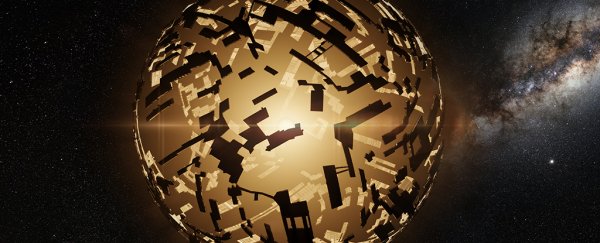Between Earth and the galactic core, there's an old, faint star that appears to have something orbiting it, something that's confusing astronomers.
The discovery joins several other stellar objects that have perplexed researchers in recent years, inviting suggestions as mundane as dust and as imaginative as extra-terrestrial technology. Whatever is responsible, it helps to have more than one object to study.
Astronomers first noticed VVV-WIT-07's odd periodic flickering during a 2012 survey of the inner Milky Way using the VISTA telescope in Chile. Now they're reporting their find, without being all that sure of what's causing it.
Routine scans of the sky often highlight objects that wax and wane in unexpected ways, leading to new discoveries.
Some clearly pulse thanks to their structure, such as the awesomely named BLAPs, or blue large-amplitude pulsators. Others dim because planets pass in front of them, or they slip behind familiar looking clouds of dust.
And then there are those that go dark every now and then because … well, care to take a guess?
In 2012, VVV-WIT-07's amplitude was found to dim slowly for around 11 days, and then rapidly fade to next to nothing over the next 48 days.
The eclipse blocked a whopping 80 percent of the measured light, providing the astronomers with a real mystery. None of the usual explanations accounted for the eclipse.
Louisiana State University astronomer Tabetha Boyajian understands the excitement too well. In 2015, she headed a study on a similar object coded KIC 8462852, which has since come to be referred to as Tabby's Star.
Unlike VVV-WIT-07, whatever material happens to be passing between us and KIC 8462852 only blocks about 20 percent of the light.
Several years later we're still scratching our heads over what could cause such an odd pattern of darkening.
The media attention might well come in handy, but Boyajian dismisses notions that alien ingenuity might be behind it.
"The new data shows that different colours of light are being blocked at different intensities," she said recently.
"Therefore, whatever is passing between us and the star is not opaque, as would be expected from a planet or alien megastructure."
That could mean it's a megastructure with tinted windows. Or maybe it's just time to let the idea go. Sorry.
Tabby's Star isn't the only anomaly found in recent surveys. In 2012, an astrophysicist from the University of Rochester named Eric Mamajek headed a study that recorded a strange flux in intensity around the star J1407.
Its oddness could have been explained by a ringed planet. But it would have to have some pretty huge rings. Rings that would put Saturn to shame, stretching out some 200 times wider than our own glorious gas giant's orbit of icy satellites.
Could rings also explain VVV-WIT-07's dip in intensity? While Mamajek isn't involved with the study, he's not banking on it this time.
"It's got to be over a million kilometres wide, and very dense to be able to block that much starlight," he told Nola Taylor Redd at Scientific American.
So… now is it aliens? Clumps of dust could still adequately explain it. And, unlike intelligent life from other worlds, we know dust exists. Interstellar clouds already block a fair amount of the star's light, making it harder to nail down its characteristics.
While changing densities in orbiting materials can't be ruled out, their configuration would be rather unusual, replacing one mystery with another.
The research team expect a repeat of the occlusion next year, so are prepared to collect more data that just might point the way to an answer.
Until then, you can hold onto hope they might identify something truly bizarre. Something that builds a case for an energy harvesting Dyson sphere or an assembling ET armada.
Just don't be disappointed if it does turn out to be a rare type of comet swarm, dust cloud, or oddly shaped binary star system. It would still mean our Universe is far weirder than we ever thought.
This research was published in Monthly Notices of the Royal Astronomical Society.
